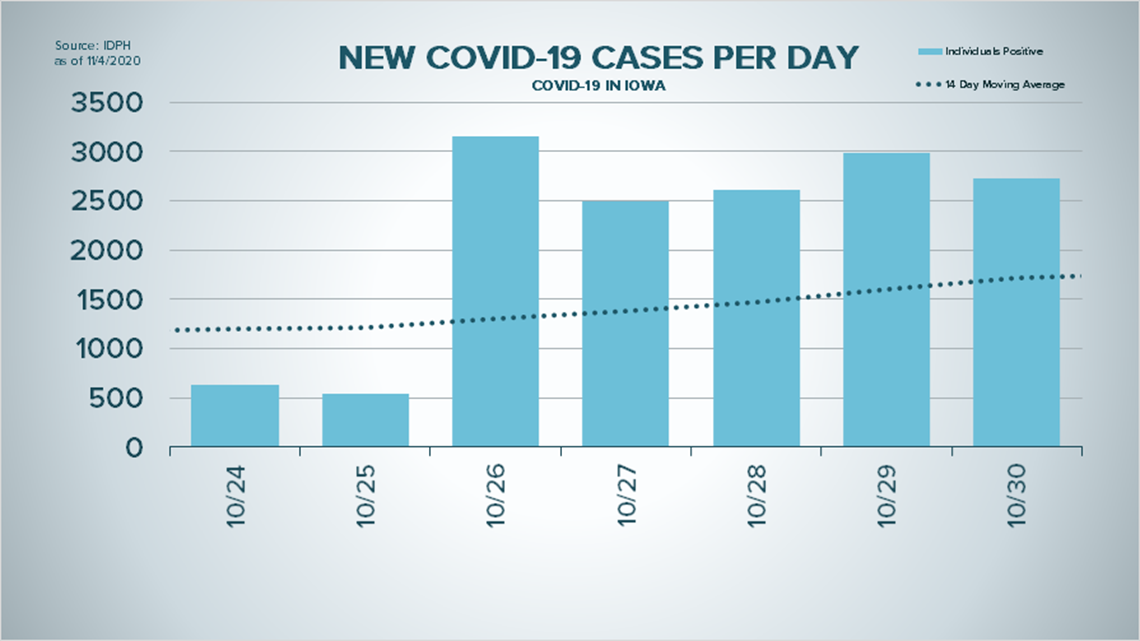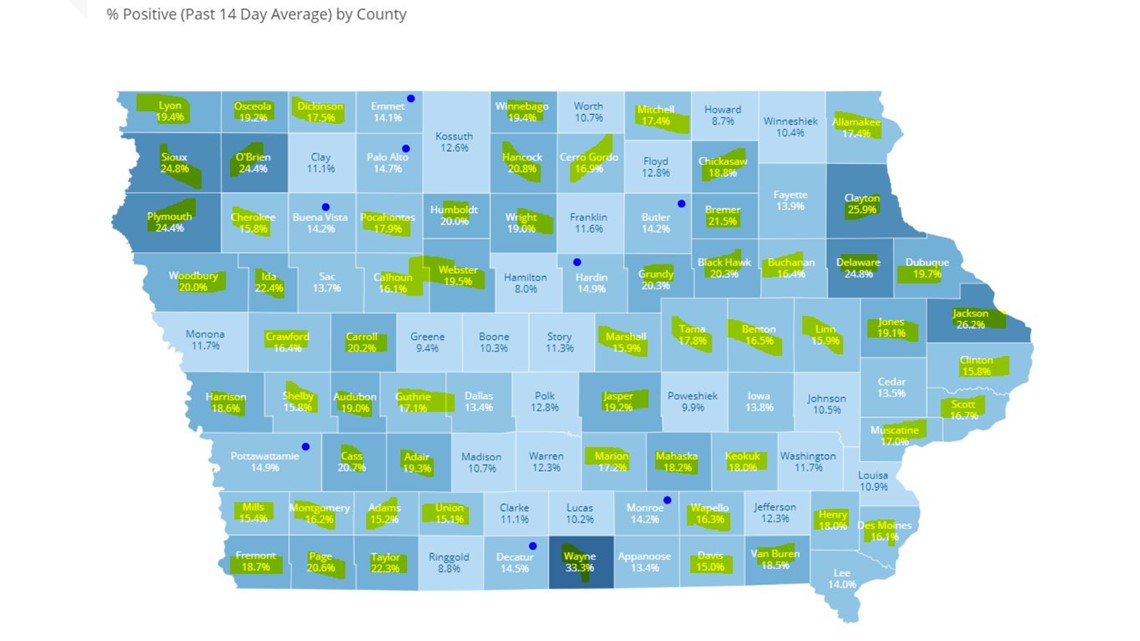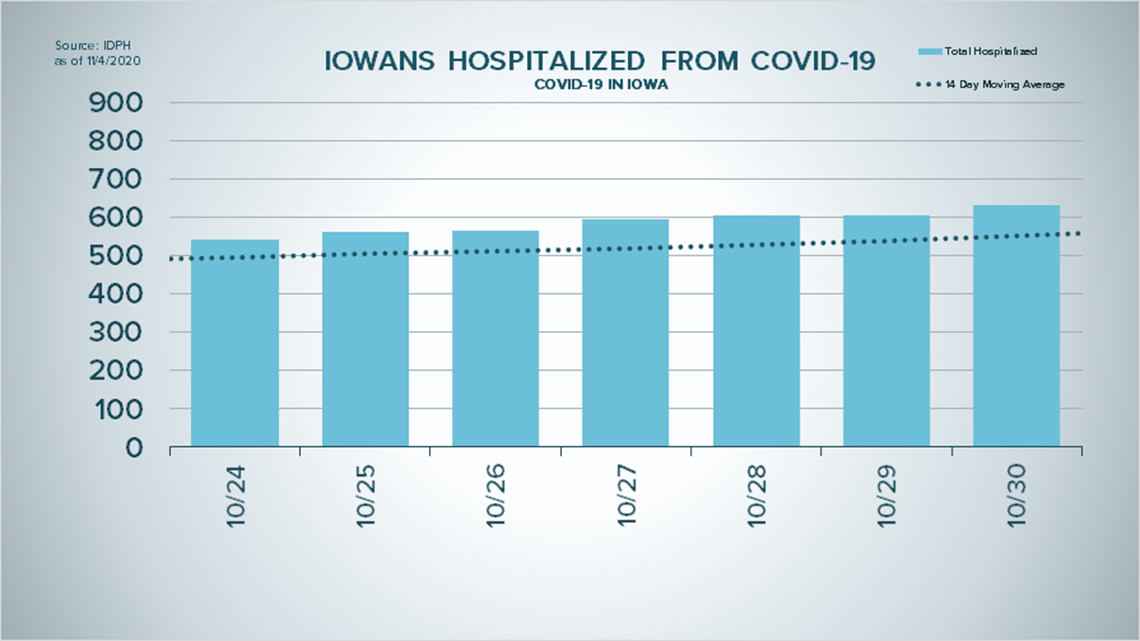DES MOINES, Iowa — Iowa continues to be a red zone for COVID-19 with the sixth-highest rate of new cases in the United States, according to the latest White House Coronavirus Task Force report.
Last week's report for Iowa stressed the need for further COVID-19 mitigation efforts in the state, and this week's report does the same.
ABC News obtained the latest report, dated for Nov. 1, on Tuesday.
Iowa's cases, hospitalizations and deaths continue to increase across the state.
As of 9 a.m. Wednesday, more than 135,000 Iowans have tested positive since March 7, 2020. The overall statewide positivity rate is 13.7%.
Last week, the statewide positivity rate was 12.6%.
Hospitalizations broke a record for the fifth day in a row with 777 Wednesday. The Iowa Department of Public Health's (IDPH) coronavirus website says 164 patients were admitted in the last 24 hours.
The report brings more context behind the numbers as well as recommendations for the state to limit the impact the virus has on the state.
Summary
Cases and test positivity
Iowa is still in the red zone for new cases, according to the report, with more than 101 Iowans testing positive per 100,000 people from Oct. 24-30. Iowa has the sixth-highest rate of new cases in the country.
Last week's report says Iowa had the 10th-highest rate for new cases.
The report says Iowa had 380 new cases per 100,000 people, more than double the national average of 165 per 100,000.
Polk, Dubuque and Linn counties had the highest number of new cases over the last three weeks, representing 22.8% of all new cases in the state. Ringgold County was the only county to report less than 20 cases in the last 14 days.
The report says 99% of Iowa's counties have moderate or high levels of community transmission. 83% have high levels of community transmission. Last week's report says 57% of counties had high levels of community transmission.


Iowa remains in the red zone for test positivity, indicating a rate at or above 10.1%. Iowa jumped from the 11th-highest rate in the country to the fifth-highest rate this week.
Wednesday morning, 61 counties reported a 14-day positivity rate above 15%. Eight counties reported a 14-day positivity rate between 14-15%.


Deaths
Iowa has the 13th-highest COVID-19 death rate in the country, according to the report. IDPH reported the highest number of deaths on Oct. 20.
A total of 22 Iowans died that day.


Long-term care facilities
From Oct. 19-25, 12% of Iowa's nursing homes reported at least one new case among residents while 33% reported at least one new staff case.
The task force says 5% of nursing homes reported at least one new death in that time.
As of 9 a.m. Wednesday, 84 long-term care facilities across the state are experiencing an outbreak with more than 2,500 cases. Deaths linked to these facilities total to 865.
The state's website, however, doesn't report a running total of cases and deaths at these facilities.
Hospitalizations
Over the last five days, IDPH has reported record hospitalization levels in the state.
The White House report says, on average, 94 confirmed COVID-19 patients were admitted to Iowa's hospitals every day from Oct. 24-30.
An average of 32 suspected COVID-19 patients were admitted to hospitals during that time. The report says more than 95% of Iowa's hospitals reported either a new case or suspected case each day during this period.


Task force recommendations
Increase mitigation efforts
The last pages of the entire task force report details the continued increase of cases, hospitalizations and fatalities across the nation. The document at the bottom of this article has Iowa and those final pages.
The maps showing new cases per 100,000 people show the dramatic increase in new cases from July to November. The most recent map shows Iowa highlighted in red.
The task force says these maps "demonstrate the previous impact of comprehensive mitigation efforts when implemented effectively in many areas and that partial or incomplete mitigation leads to prolonged community spread, hospitalizations and increased fatalities."
Gov. Reynolds began loosening restrictions in May, citing the downward trend in cases during the last few weeks of April. The White House says the loosening of these restrictions could be why Iowa is seeing such a dramatic increase of community spread.
As for masks, the task force recommends enforcing all students and teachers in K-12 schools wear them.
The task force also recommends limiting indoor restaurant capacity back down to 50% and restricting hours until cases and test positivity decrease.
Increase testing, access to treatment
The task force says the IDPH coronavirus website shows "minimal testing" for asymptomatic people and recommends Iowa change its testing strategy to find more asymptomatic people that may be spreading the virus unknowingly.
Prioritizing the use of Abbot BinaxNOW testing is also encouraged by the White House, especially among health care workers, prison staff, K-12 teachers and first responders.
These tests should also be used to locate asymptomatic patients to stop the source of the spread. The task force recommends testing those younger than 40 years old.
The task force recommends implementing weekly sentinel surveillance among these populations "to provide detailed trend data on where the virus is and direct mitigation efforts."
This is also applicable for Tribal Nations.
The task force recommends providing these areas with Abbot BinexNOW tests to conduct weekly testing among everyone.
The task force also recommends confirming cases with PCR testing and realigning contact tracing staff to support new testing approaches in areas with low test positivity. Integrated surveillance data should be provided on the state's website for community members to see local virus changes.
While the state doesn't provide zip code data on virus activity, some counties, like Polk, do.
"Behaviors seem to be eroding in university towns with increasing cases and test positivity," the report says.
The task force says Iowa should review testing efforts at universities to make sure all students (on and off campus) are being tested weekly.
The state is encouraged to work with universities to implement weekly testing protocols among universities.
WATCH: Complete coronavirus coverage from Local 5 on YouTube
Informing communities with clear messaging
The task force encourages Iowa officials to increase clear messaging across the board to Iowans, especially since hospitalizations doubled over the last month.
Examples include:
- Do not gather without a mask with individuals living outside of your household
- Always wear a mask in public places
- Stop gatherings beyond immediate household until cases and test positivity decrease significantly
The task force recommends creating public service announcements on "taking smart actions to stay open, including targeted messages to rural communities."
READ: The Iowa section of the White House Coronavirus Task Force report

